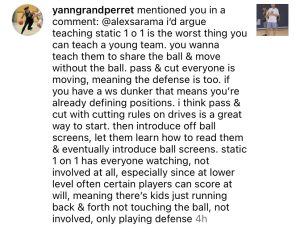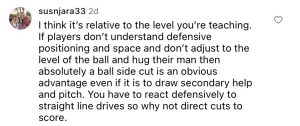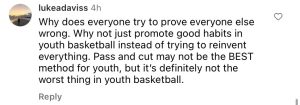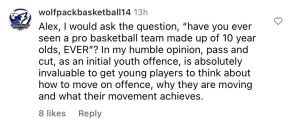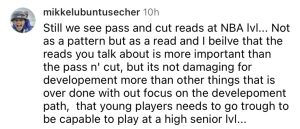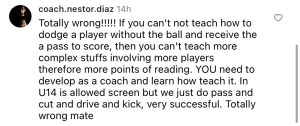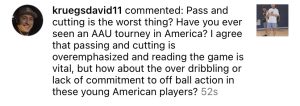Why Pass and Cut Motion Offense is Harming Youth Basketball

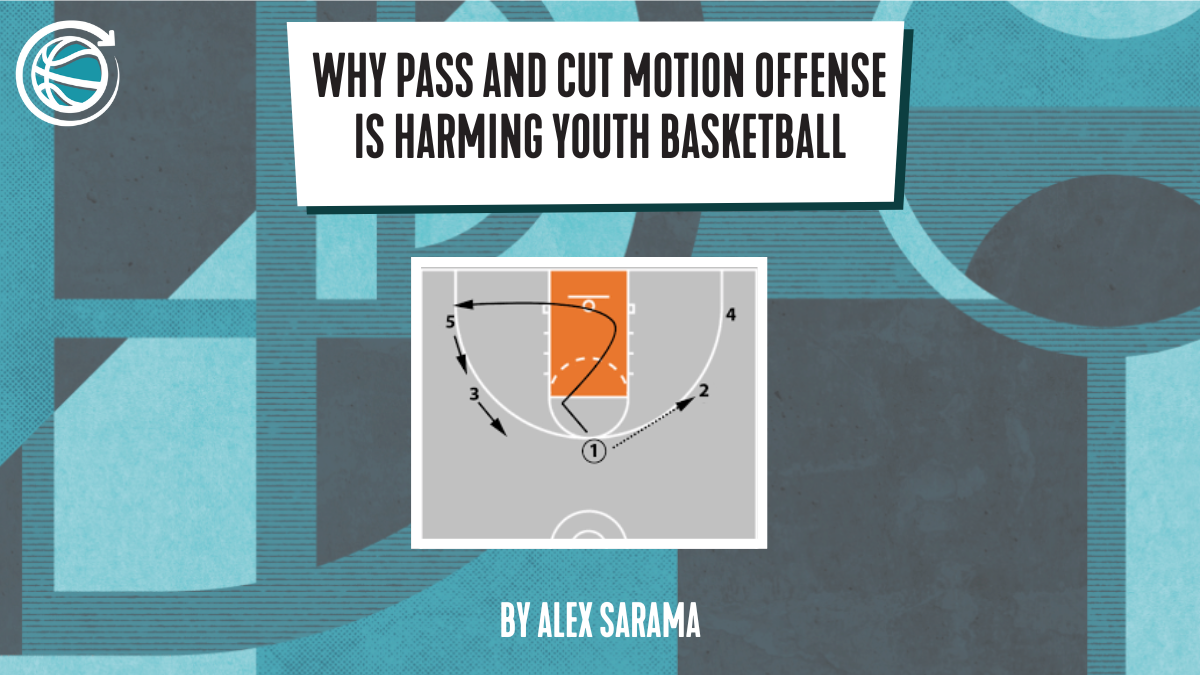
A post on the Transforming Basketball Instagram page went viral a few months’ ago speaking about the ineffectiveness of pass and cut motion offense. To begin with, let’s be completely clear. We are not talking about an opportune pass and cut, a backdoor cut, a weakside ghost cut, a cut off a post-up, etc. Instead, we are referring to the repeated 5 out automatic pass, cut, fill offense that many youth teams use. These are two very different contexts of cutting.
The type of pass and cut seen in the video above is NOT pass and cut motion offense. This is an opportune cut as Victor Wembanyama perceives the attractive affordance to cut as the defender is out of position. Even though affordances such as this appear relatively infrequently in each game, this can still easily be developed without relying on a pass and cut motion offense.
Pass and cut is what many coaches believe in for youth offense. This has become its own form of life in the basketball world. It can sometimes come across as ‘personal’ when deeply entrenched ideas that are cherished within coaching circles (such as pass and cut) are challenged. It is critical to note that we are challenging the idea and the philosophy: not the individual coaches themselves who are utilising pass and cut offense. We simply want to use this blog format post to factually lay out why we believe the basketball world needs to ditch pass and cut to develop more skilled youth players! Just some of the comments on the original post show why it is important to unpack this argument in a rational manner.
- Screenshot
- Screenshot
- Screenshot
- Screenshot
- Screenshot
- Screenshot
- Screenshot
- Screenshot
- Screenshot
- Screenshot
- Screenshot
- Screenshot
- Screenshot
- Screenshot
- Screenshot
“It Creates Motion to Move the Defenders”
Sharing the ball for sharing the ball’s sake is not good offense. When players perceive the affordance (opportunity) to pass, this should be because the environment affords it as being an attractive solution. For instance, the teammate who receives the pass is in a scoring opportunity or a chance to set-up a scoring action. Passing and moving repetitively merely because it is prescribed by the coach is not an effective rationale for passing.
Within pass and cut offenses, the passes completed by the offense are not decisive enough to create tangible advantages (specially when compared to the other alternatives that we will get to later on). Just because the offense and defense are moving, motion alone does not equate to efficient offense. A team could move continuously for 24 seconds of a possession and then have no time left to find a good shot. Meanwhile, a team could aggressively drive and find an open rim finish within two passes. What offense is more efficient and effective?
Furthermore, many coaches believe that players have to move every time after passing the ball. But is this really the case? Sometimes it could be more optimal to simply wait and maintain great spacing, being ready to move based on what happens with the teammate receiving the ball. For instance, if they decide to drive, if a player has maintained great spacing (essentially by standing still/ getting back out to space) they are ready to react to the dribble penetration through a push, pull or potential ghost cut.
“It Teaches Spacing and to Purposefully Cut”
Teaching a repetitive pattern is incredibly limiting in the context of youth basketball. Young players simply do not have the experience to know when to break from the pattern to act upon a natural scoring opportunity because they are so focussed on running the coach’s offensive pattern. Such patterns, such as pass and cut, merely prevent players from being aggressive and looking to create advantages for themselves or teammates (e.g. through quick static or dynamic 1-on-1 opportunities at younger ages). The pass becomes a crutch where players can simply pass and move and hope that another teammate does something decisive.
Furthermore, spacing can easily be developed through far more effective solutions. Take Transforming Basketball’s “Floor is Lava” concept, which has been adopted by coaches at all levels from the NBA down to grassroots. Catching the ball inside the mid-range, unless playing out of the dunker or completing a weakside cut, is a turnover. When applied to any practice activity or scrimmage, you will see representative spacing emerge as players attune to the available space and their teammates. This can be implemented effectively in just one practice.
“It Teaches Players About Offense”
At Transforming Basketball, we actually believe that pass and cut offense develops into a rate limiter which coaches have to counter at higher ages. This is because all the conducive offensive solutions that players should attune to at younger ages are negatively reinforced by pass and cut.
For instance, ball manipulation and aggressively beating a defender should be a key focus of youth basketball. Note, this is not a 10 dribble iso possession, but simply the ability to efficiently create an advantage in one, two or three dribbles. If this cannot be done, then players may recognise neutral and moving the ball onto another teammate. If players spent more time doing this, it would naturally prepare them to be more skilled players as they grow up, being more prepared for scenarios such as handling the ball in pick and roll. However, pass and cut removes opportunities for players to do this. Coaches can also use constraints in both practices and games to ensure different players have opportunities to create through 1-on-1 instead of having one or two players dominate possession.
We believe that players need to encounter as many affordances as possible within games to prepare them for what comes next (high school, collegiate or even professional basketball). Therefore, the valuable developmental opportunity provided by competition is made redundant when coaches insist on using outdated offenses. This is because players are not encountering representative affordances that will help them when older. This is even more of an issue if players are coached through the dominant style in practice as they are encountering far fewer opportunities to make real decisions. This is what is meant by the context of preparing youth players as best as possible for the adult game as opposed to doing something (pass and cut) that would never be done as an offense at the collegiate or professional level.
“Pass and Cut Creates Space”
Firstly, pass and cut actually removes space. This is because the automatic fill cut immediately brings a gap defender towards an offensive player who may be driving. Furthermore, because the paint is always clogged by a cutter, it removes opportunities to off-ball cut. These affordances (to ghost cut) are absolutely critical to develop skilled offensive players who have an awareness of space and the defense.
Dominoes – the ability to convert an advantage – is the foundation of any offense. If the offense have a temporary advantage, pass and cut motion simply does not attune players to finding ways to use it, as players keep on repeating the pattern. In the past when I have done 3-on-2 or 4-on-3 advantage activities, I often see youth players immediately pass and cut. This has happened in multiple countries on multiple continents as I’ve delivered coaching clinics and youth camps. Surely enough, pass and cut doesn’t allow players to convert the advantage as this continuous cycle allows 1 defender to guard 2 and negates the permanent +1 advantage which is provided for within this activity. The players have not learned to attune to key variables such as the location of the ball, their teammates, defenders, etc. Instead, all they have done is complied with the coach’s instructions to run a pattern.
Effective spacing can easily be developed through other methods, which are more conducive to the way basketball is played in the 21st century. For instance, utilising the weakside dunker more in youth basketball and ensuring a different player is there every time (as opposed to designating the same player to operate from there on each possession). This creates vertical and horizontal spacings and allows players to convert dominoes through simple 1-on-1s. This is one way to already have double gaps created in an offense without having to even create a gap through a cut.
“Static 1-on-1 Is Not a Good Habit”
We were some of the first people in the basketball space to talk about the dangers of static 1-on-1 and what is happening with all the coaches and trainers teaching isolation 1-on-1 moves which have no correlation to triggers and how offensive basketball is played. This is how we came up with the “License to Kill” framework so that older players can recognise when the static 1-on-1 is effective.
However, we cannot shy away from the fact that the easiest (and we would say most effective way) to create an advantage at U12’s and under is through static 1-on-1. At this age group, simplifying to 1-on-1 increases ball manipulation skills and allows players to focus on their spacing and dominoes conversion.
This allows all players on a team to work on their advantage creation and being confident and aggressive trying to beat a defender. This does not mean that four other players off the ball stand still and watch. Their job is most important: they are continually finding windows, reacting to the potential dribble penetration with push/ pull, looking for ghost cuts if their teammate penetrates, etc. The player who originally created the advantage 1-on-1 is then likely to get off it, with the whole team getting ready to play in 0 seconds and convert the dominoes. In other words, the total opposite to standing still and watching one player isolate. Just because this is often seen in AAU, this does not mean this is how isolation basketball should be played!
The goal is then to build up to other triggers (e.g. gets), which can come after starting with an emphasis on 1-on-1 and dominoes. When players eventually play pick and roll later on, the skills developed from this will transfer. Take something like the reject. This is an important affordance we want players to attune to, but the actionability of this ability is actually hindered by running passing motion offenses (Yes – this is also why we don’t like offenses like Princeton. At the end of the day, there is still a fixed pattern).
Playing without pass and cut does not mean one player in a youth offense will do all the work while everyone else watches. The idea is to involve everyone in order to start dominoes. This could easily be solved in a practice activity through constraints: e.g. the first team to win this 3-on-3 activity is the team who scores off a 1-on-1 with all their different players involved in starting the advantage. The constraints of this task will require three different players on each team to create dominoes through the 1-on-1. This creates an intelligent practice task where players must have specific intentions and share the advantage-creation duties.
“Players Need Basics First”
What even are the basics? Why do we still believe in the idea that youth players have to do certain things before they are capable of more advanced movements? This is one of the biggest misassumptions in the coaching world. Not only does this go against all the science, but simple common sense.
A good example of the traditional ‘basics first’ mentality that many coaches still adopt in the present day.
If coaches believe that the goal of basketball is to develop compliant players who always move from point A to B when instructed, then run pass and cut… But if you want to develop adaptive, skilled, dexterous players, we need something else. The ‘basics’ (if we even want to call them that) need to be reframed to focus on using dominoes, creating advantages, seeking out higher value shots. This can easily be achieved through Transforming Basketball’s vision for youth offense, outlined below…
What’s the Alternative?
- At U13 and below, focus on dominoes spacing and using the weakside dunker. Every player should be encouraged to beat their defender in a few dribbles. If this can’t be done, move it on and re-space, getting ready to react to any potential dribble penetration. When players demonstrate skilled intentionality with basic spacing concepts, coaches could consider introducing a more complex trigger such as a get.
- Different players should handle every time. The same players doing this over and over again hinders development.
- Mix in some dynamic 1 on 1 where players attempt to create dominoes through a blast cut (cut from a double to single gap). This can complement static 1-on-1 and is enough for an offence in its own right at younger age groups.
- Playing through post ups could be another nice idea for younger age groups (e.g. U12, U13, U14). This promotes effective spacing intentions as well as affordances to cut off the ball. This could easily be paired with utilising the weak side dunker.
- Avoid any type of motion offense which repeats itself. Instead, play with ‘principles of play’. Motion offense are a false impression of what basketball is about. Players start to think that basketball is about patterns, whereas really it is about principles.
Coaches often find it challenging to coach with uncertainty by adopting the conceptual principles listed above. It’s easier to control everything through pass and cut because the coach always knows what should happen. Utilising principles and variability therefore seems to make the coach appear weak given how they ‘lose’ a sense of control and cannot predict what will happen. However, as with every coach who believes in Transforming Basketball’s methods, we know that the ability to bring principles of play to life is the hallmark of any effective contemporary coach.
A shout out to Coach Sam Adams who also shared some great ideas on our YouTube in regard to embracing the alternative…
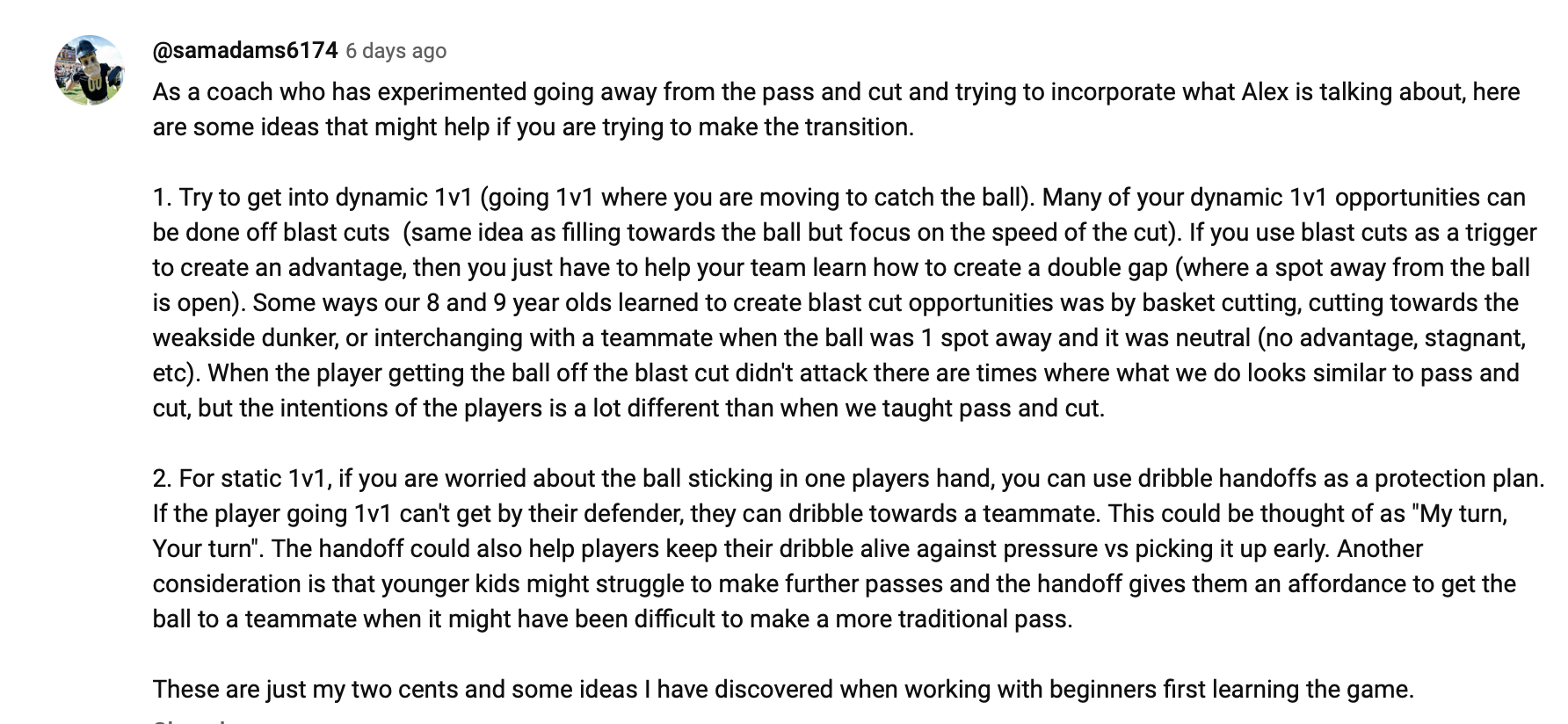
Listen to Alex’s Podcast Episode on this topic, which also answers many of the comments we received on our original Instagram post!






